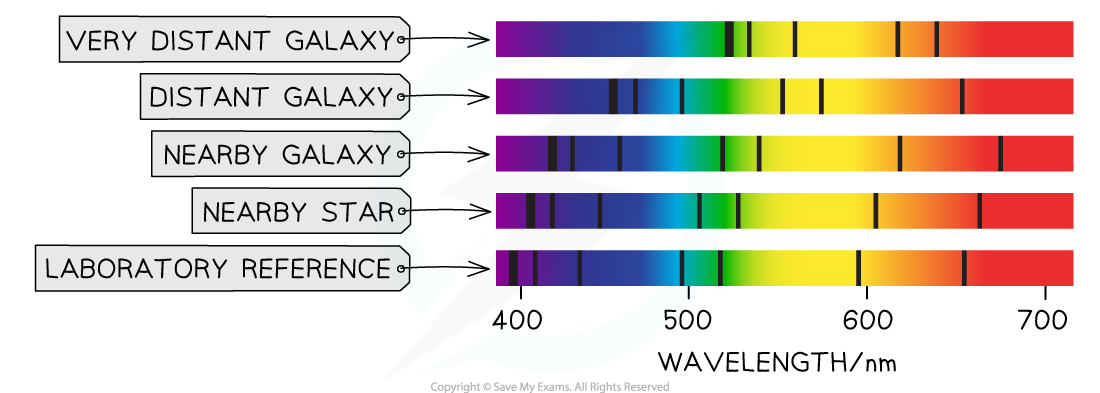Age of the Universe (Cambridge (CIE) IGCSE Physics): Revision Note
Exam code: 0625 & 0972
Did this video help you?
The Hubble constant
Extended tier only
When Edwin Hubble looked at the absorption spectra of distant galaxies, he determined a relationship between the speed of a galaxy and its distance from Earth
Comparing redshifts of galaxies

Hubble discovered that all galaxies show redshift, but the galaxies that are further away show a greater increase in redshift
This is Hubble's law, which states
The speed of recession is proportional to the distance of the galaxy away from Earth
'Recession' speed means the speed at which something is moving away
This means that the further away a galaxy is from Earth:
the faster it is moving away
the greater the increase in redshift
Relationship between redshift and galaxy distance

Hubble's law tells us the greater the distance to a galaxy, the greater the redshift, or the speed it moves away from Earth
Hubble’s law can be expressed as an equation:
Where:
H0 = Hubble constant (per second)
v = recessional velocity of an object, the velocity of an object moving away from an observer (km/s)
d = distance between the object and the Earth (km)
From this equation, the Hubble Constant
can be defined as:
The ratio of the speed at which the galaxy is moving away from the Earth, to its distance from the Earth
The accepted value of the Hubble constant is
= 2.2 × 10–18 per second
Examiner Tips and Tricks
Make sure to learn the currently accepted value of the Hubble constant.
You will be expected to know that the current estimate for H0 is 2.2 × 10–18 per second
Measuring recession speed & distance
Extended tier only
The Hubble constant
can be determined from measurements of:
redshift of the light emitted by a galaxy
the brightness of supernovae in the galaxy
Measuring recession speeds of galaxies
The speed of recession
of a galaxy (i.e. how fast it is moving away from the Earth) can be found from the change in wavelength of the galaxy’s starlight due to redshift
Measuring distance using supernovae
The distance
to a galaxy can be determined using the brightness of a supernova in that galaxy
Supernovae are exploding stars
Certain types of supernovae have the same peak level of brightness (absolute magnitude), meaning they can be used as standard candles
These supernovae are so bright that they can be used for measuring distances to the most distant galaxies
Age of the Universe
Extended tier only
Hubble's law can be rearranged to give the expression:
Since time is equal to distance divided by speed, the term
represents an estimate of the age of the Universe
Hubble's law provides further evidence for the Big Bang
It shows that the Universe has been expanding since the beginning of time
If we looked at time in reverse, we would see galaxies were closer together in the past
This suggests that the Universe must have originated from a single point and has been expanding outwards ever since
Hubble's law graph
Using measurements from galactic redshift and brightness of supernovae, a graph of recession velocity against distance can be plotted
Graph of galaxy recession velocity against distance

A key aspect of Hubble’s law is that the furthest galaxies appear to move away the fastest
The gradient of the graph represents the age of the Universe
When the distance equals zero, this represents all the matter in the Universe being at a single point
This is the singularity that occurred at the moment of the Big Bang
Astronomers have used this formula to estimate the age of the Universe is about 13.7 billion years
Worked Example
A distant galaxy is 20 light-years away from Earth.
Use Hubble’s law to determine the velocity at which the galaxy moves away from Earth.
Answer:
Step 1: List the known quantities
Distance to the galaxy,
= 20 light-years
1 light year = 9.5 × 1015 m
Hubble constant,
= 2.2 × 10−18 per second
Step 2: Convert 20 light-years to m
= 20 ly = 20 × (9.5 × 1015) = 1.9 × 1017 m
Step 3: Substitute values into Hubble's Law
The galaxy moves away from Earth at a velocity of 0.42 m/s
Examiner Tips and Tricks
If you are taking the Extended paper, remember that you have to learn the values for a light year and the Hubble constant!

Unlock more, it's free!
Did this page help you?